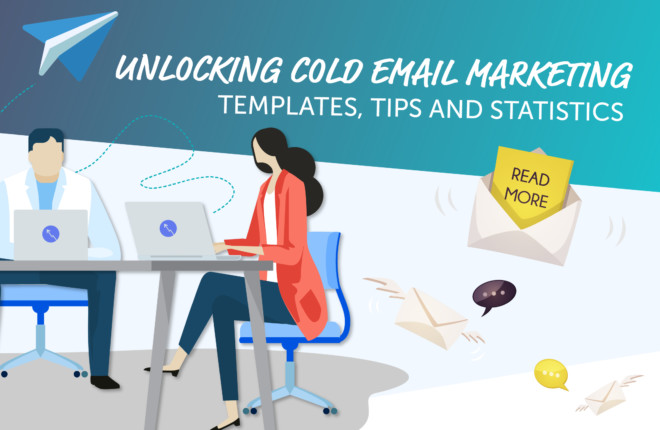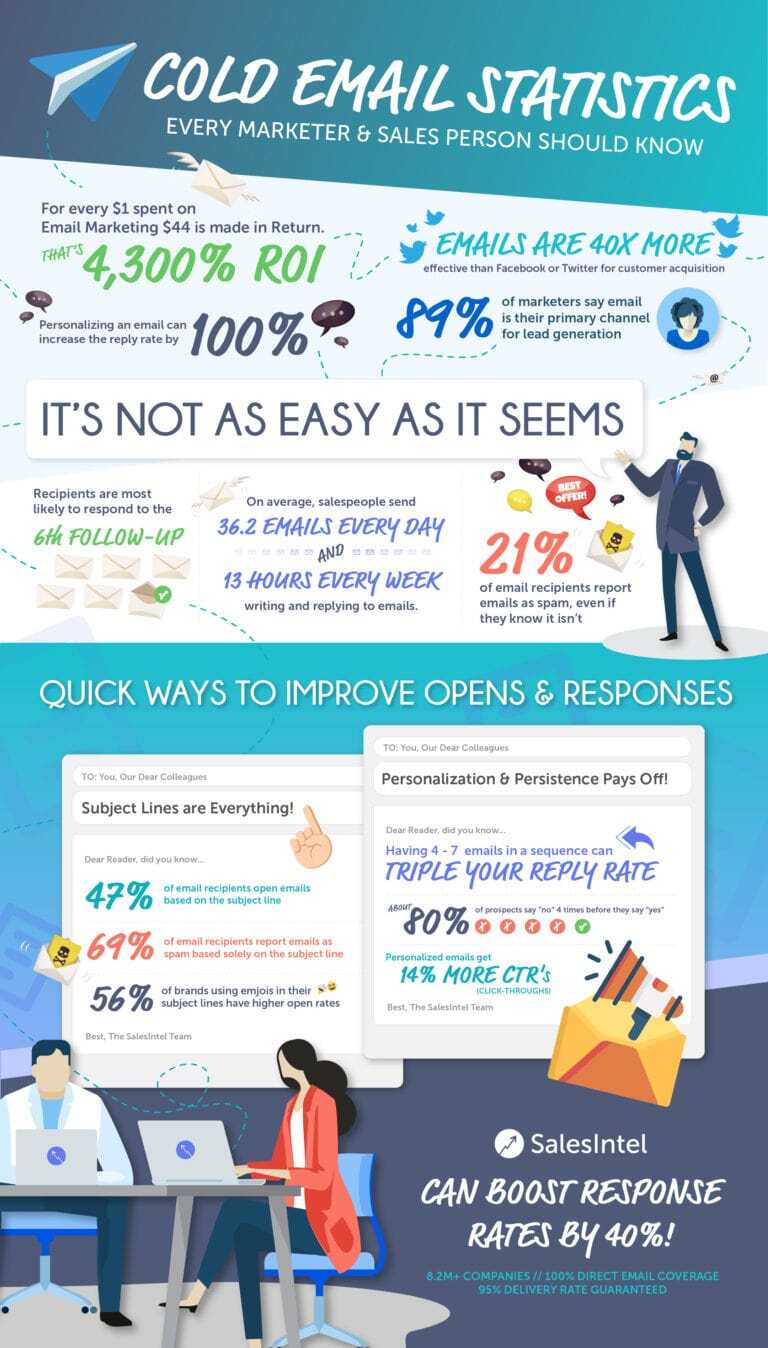There are currently 28,893 emails in my inbox.
I am not sure which ones I signed up for and which ones are pure cold emails but it is almost certain that I won’t read or respond to even 0.1% of these. Now if you think about it, most of these emails have been carefully crafted and sent by real marketers and salespeople trying to create engagement and generate leads.
So where did they go wrong?
Here’s the answer: there is something fundamentally wrong with how most marketers use cold emails.
Email marketing, on the surface, is one of the best sales tools because a) it is inexpensive and b) it delivers high ROI when done correctly. It is estimated that for every dollar businesses spent on email marketing, companies get $44 in return!
But there is a catch – randomly shooting emails to massive lists isn’t email marketing. It’s spamming.
If you want to truly make the most out of your email campaigns, you must understand the three basics:
- The dynamics of marketing emails
- Keen understanding of your audience
- Crafting your message
Dynamics of Marketing Emails
Marketing emails of any kind have three core components:
- Introduction – This includes introducing yourself/brand to the recipient. It also covers how you greet your audience. For instance, a “Hi, First_Name” is always more impactful than a generic “Hi.”
- Pitch – This section includes the core message of the email, including the purpose for which it is sent. For example, if you want prospects to demo your product, explain how they would benefit from it and how some of their peers are already taking advantage of your product.
- Call to Action – This section includes what you want the recipient to do after reading the email. It can be either clicking on a link/button or simply replying to the email. The first approach is always better because clicking on a link has far less friction than typing a reply.
Depending on how these three components are balanced, they fall into one of these three categories:
Cold Emails
These are personalized emails with particular focus on introduction and pitch. Generally, they are sent from a personal account and address the recipient by name. The core purpose of these emails is to generate engagement. They are often designed to be sent in sequence, say 5 or 7 in succession. The emphasis on CTA grows with every successive email.
Take a look at the below cold email and you’ll notice an overwhelming focus on the pitch with minimal emphasis on CTA. This gives the recipient a sense of comfort – that the other person is really trying to help and isn’t just pushing to sell.
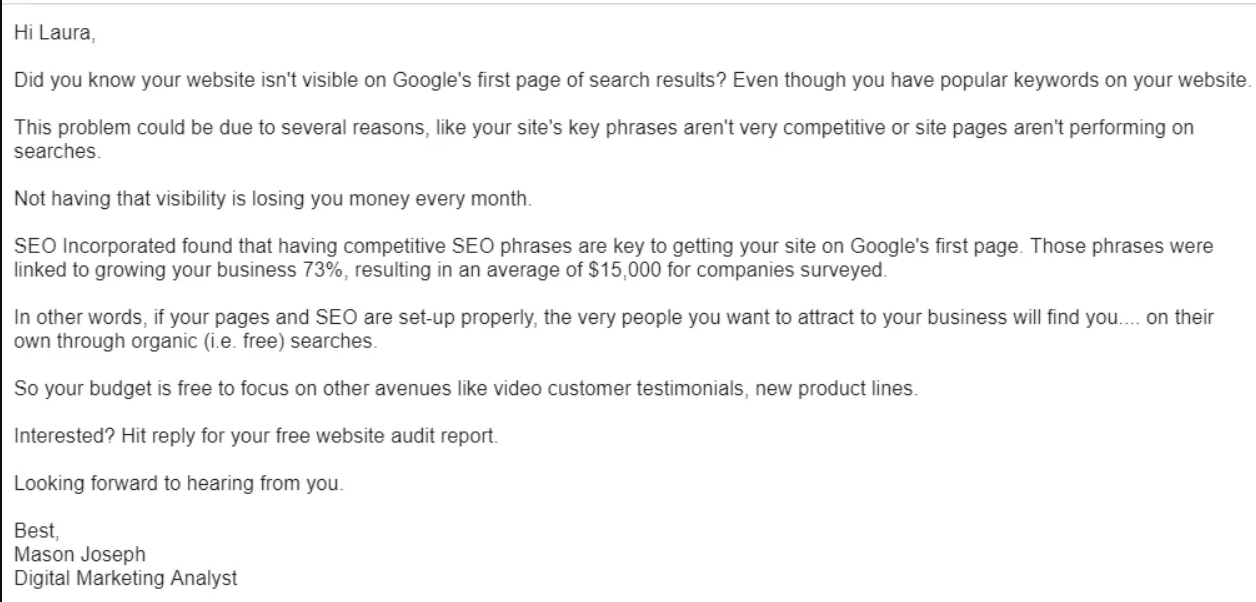
There is, however, one problem with this email – the sender hasn’t introduced himself properly. Except for the email signature, there is nothing that says who the sender is or what they do. This might make the recipient skeptical and prevent them from responding.
Promotional Emails
These marketing emails have a particular emphasis on CTA with minimal introduction or pitch. Generally, they are sent in bulk, have graphical elements {for aesthetics}, a bit of personal touch (like addressing recipients by the first name), and are sent repeatedly over time intervals.
The CTAs on these emails are almost always clickable buttons and the core purpose is not mere engagement but action.
For example, NYT has been sending me these offers “ending today” for months!
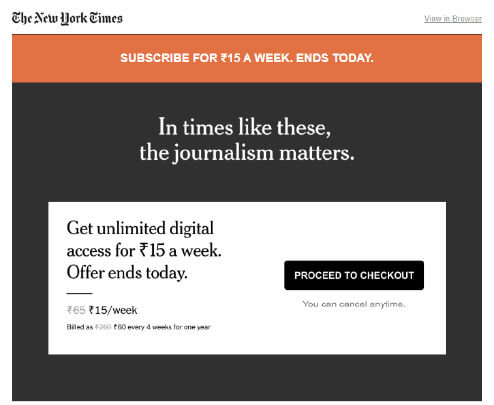
Spam
There are two kinds of spam emails. Depending on which kind they are, they can look like either cold or promotional emails.
The first kind is simply illegitimate and is sent to steal the recipient’s information or to scam them. The image below is a classic example of this kind of spam email because I swear I do not have a $2.3M consignment heading my way (and I can guarantee Charles isn’t from the IRS either).
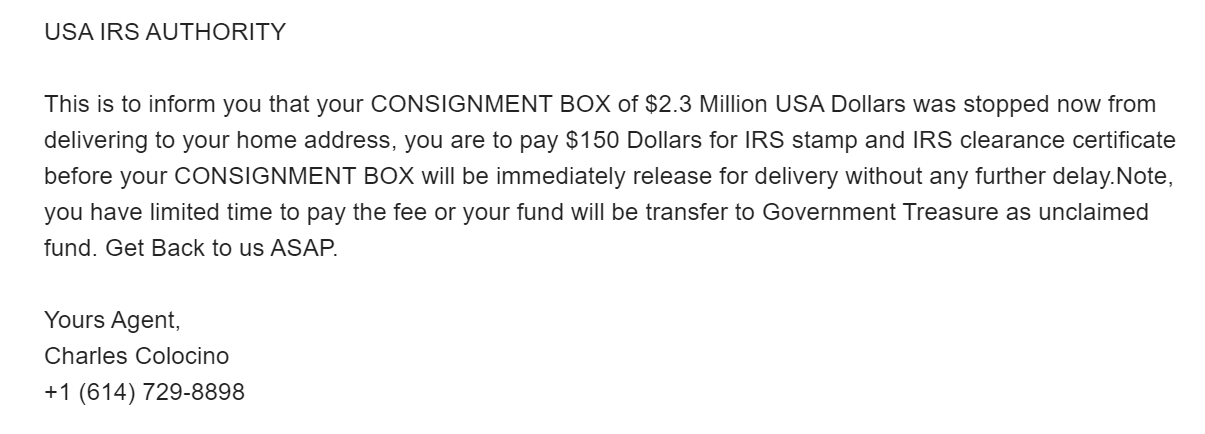
The second kind is a legitimate cold or promotional email, but the email service provider {Gmail, Outlook, etc.} marks it as spam based on the sender’s poor domain reputation. More on this later. Also, it’s been found that 21% of email recipients report email as spam even if they know it isn’t. (I certainly have done that on many occasions, have you?)
The point is, the only thing keeping your cold emails from becoming spam are recipients themselves. Thus, it is critical to ensure that your emails are received by the right audience and have the right message. That brings us to the next part of this article.
Keen Understanding of Your Audience
Understanding the audience and sending them emails accordingly lies at the heart of every successful cold email campaign. Many marketers struggle with email marketing simply because they do not have the right information about their target customers. You can’t simply purchase an email list of 100,000 people, send an email blast, and expect to receive good responses and high-quality leads. It just doesn’t work!
You need to get the basics right:
1. Sending to the right people
First of all, it is important that your emails are received only by the people you are specifically targeting. If you blindly send a cold email blast to all your contacts, not only would it yield poor responses, it would also damage your brand reputation and hurt your future email campaigns. So how do you do it?
Start by defining your ICP and build a list of companies matching those criteria. Next, you need a list of contacts at those accounts, which should ideally include a mix of high-level executives and mid or low-level employees. So if there are 1000 companies matching your ICP and you have at least 10 contacts at each of those accounts, you get a list of 10,000 emails. Sending emails to only these contacts would yield much better results than sending to all your contacts.
One problem many businesses have is that they do not have this contact data to begin with. In that case, you can sign up for a data provider like SalesIntel to get all the data you need.
2. Sending the right message at the right time
Sending emails to the right people by itself isn’t enough. You need to further filter them to get a list of prospects most likely to engage with your outreach and eventually convert into customers. To continue with our earlier example, if you have a list of 1000 accounts, not more than 100 would be in a purchasing mode or exploring new solutions at any one point of time.
Use intent data and business insights to zero-in on those accounts and dedicate most of your marketing efforts towards them to get maximum traction. If you don’t have access to such data points, you can sign up for SalesIntel that delivers the best contact and business data to help you find your next customer.
Finally, it comes down to what message your emails convey. You can find the perfect customer but if they don’t find your message appealing enough, it’s all for nothing. So as important as finding ideal customers is, knowing what to say after “Hi” is equally important. Here’s what you ought to know:
Crafting the Message
Honestly, there is no perfect cold email that every recipient would read or respond to. The reason cold emailing is so tough is that there are too many moving pieces. In fact, something as benign as the time you send your emails or the particular words in the subject line can drastically affect your chances of success. Just think about it – you find the right customer, write the perfect pitch, but just because you sent it an hour late or early, you’ll get fewer responses! (On a related note, the best time to send an email is between 10:00 AM to 12:00 PM and 4:00 PM. Also, Wednesdays and Thursdays tend to have more engagement).
That said, here are a few red flags you must avoid and best practices you must embrace:
Get to the Point!
Some marketers consider emails as an opportunity to tell stories. They write long emails detailing their products and proposals and then wonder why don’t prospects respond to their emails! Well, because nobody reads them.
Consider cold emails as a written form of your elevator pitch. Make it crisp, impactful, and intriguing, but most importantly, keep it short! If your cold emails are longer than 150 words, you need a complete rework. 75-100 words are considered ideal for cold emails. Anything shorter or longer indicates you have room for improvement.
Missing the Mark
We have all received those emails that we know do not belong to us. They might address us by a different name, have content that we aren’t remotely interested in, or simply try to fool us with some catchy subject line.
For example, I recently received an email with the subject line, “Oh, no, you missed our webinars!” I checked my inbox and calendar, and nope, I had never registered for the webinar. In fact, I had never even received an invitation to the webinar which I purportedly missed. So I promptly reported it as spam and moved on.
The point is, if the company had carefully segmented their audience, as discussed earlier, they wouldn’t be in this position. And if you do this often {by intention or mistake}, you’ll soon damage your domain and brand reputation sending your email campaigns on a downward spiral.
The Trade-off
You must understand that engagement and clicks aren’t the same. A recipient might be engaged with your email outreach but still not click or respond to it. Or they might click once or twice (due to some clickbait or urgency), but otherwise do not engage.
You must decide what you want to achieve and craft your message accordingly. Take the following email as an example. It asks the recipient to take a survey and also informs them beforehand that it would take around 7 minutes.
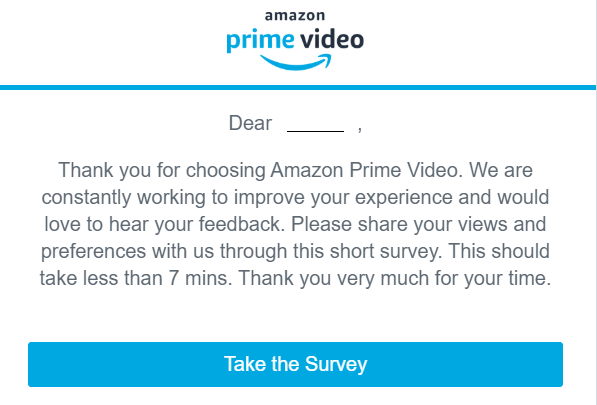
Now, here’s the trade-off. Seven minutes is a long time, particularly when the recipient isn’t going to get anything in return. So it is obvious that very few people would click. But then, the ones who do click are most likely to complete the survey because they have already committed the requisite time.
Now, if the email said the survey would take only 60 seconds, it would have certainly received many more clicks but then most of them would have dropped off without completing the survey.
Since the objective of this email was to get the recipients to take the survey, they chose to not go after clicks and implicitly mentioned click only if you have 7 minutes to spare. Similarly, you need to define your priorities beforehand and tailor the message to suit that purpose. It is okay to use clickbait if all you want is maximum clicks and don’t care about engagement.
Be Proactive
Most cold emails end with something like “Let me know”, “Looking forward to your response”, etc. The problem is, these are passive statements that a) do not force the recipient to respond; and b) create friction even if they want to respond.
For instance, if you end your email with “Let me know” and the recipient if interested, the onus of thinking about a response and an appropriate time to call falls on them. But if you end your email with something like “Are you free Tuesday evening at 4:00 for a quick call? Or anytime between 4:00 to 6:00 works for me” and they are interested, all they have to do is type “yes” or “Make it 5:30.”
Now that you have a fair understanding of how cold emails work and how you can make the most out of them, let’s a look at few cold email templates that encapsulate all of the above lessons:
Cold Email Templates
The four templates below are suited for different scenarios that most salespeople or marketers often come across:
1. When you know the activities of your target customer
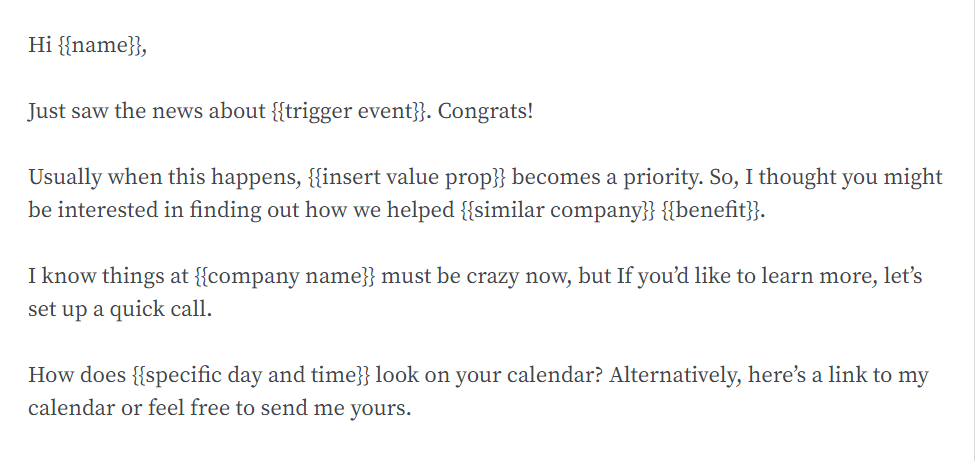
This clearly reflects that the email hasn’t just been shot off randomly but the sender has done his research. It’s timely and it offers a relevant value proposition by including how you have helped similar companies in similar situations.
2. When your target customer is already using a product/service like yours
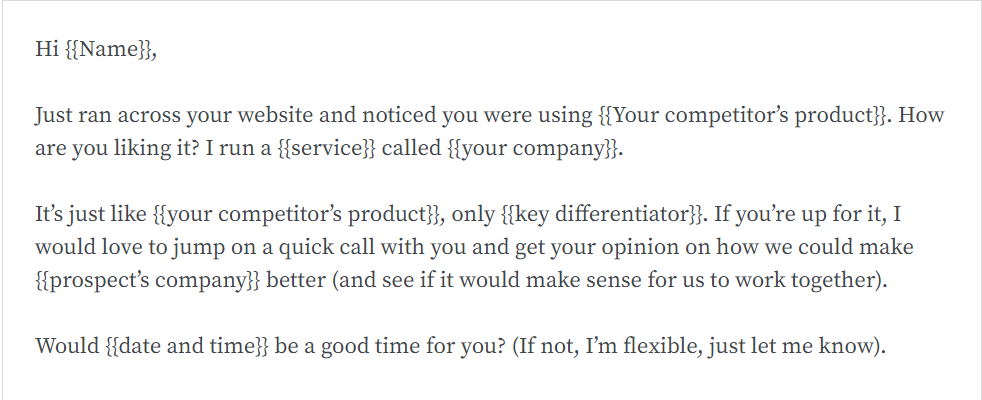
These kinds of emails best work for startups and smaller businesses. The sender is upfront about their objective and because they mention what product the receipt already uses, it gives a sense that the sender has done their homework.
3. When the target customer is engaged with your website/content
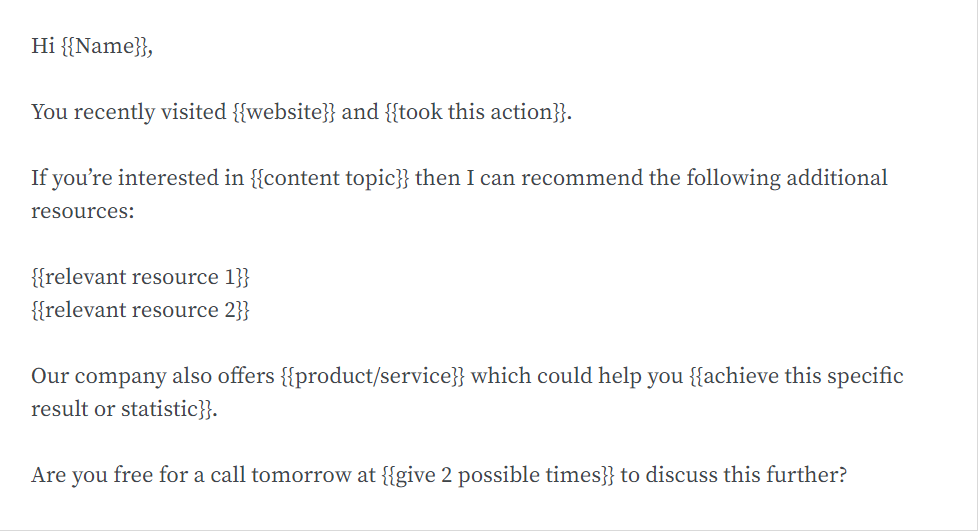
This email strikes a fine balance between nurturing and sales push. It lets the recipient know that your company actively monitors and engages with its prospects. Even if they do not agree to a call immediately, they’ll look out for you when they are in the market for a similar solution.
4. When you are simply nurturing
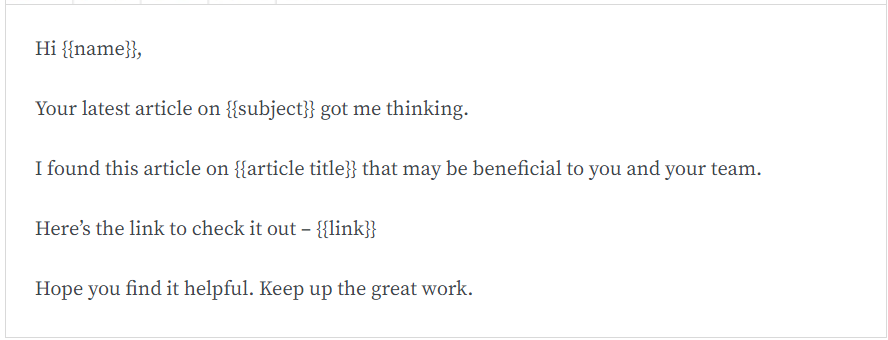
This is an example of cold email with zero emphasis on CTA. It’s mostly used when you are pursuing a large account and engaging multiple POCs with dozens of email sequences. These emails are meant only to let the recipients know about your product and create some good faith by sharing some valuable resources.
Cold Email Statistics
Closing Remarks
If we try to summarize everything we have discussed into a single line, it is this – Cold email marketing is one of the most effective and profitable channels if you do it right.
Now, doing it right constitutes of two parts:
- Getting your structure and content of your emails right
- Reaching out to the right people at the right stage in their buying journey
As far as SalesIntel goes, if you take care of the first part, we will deliver the rest. Request a live demo see how it works.

